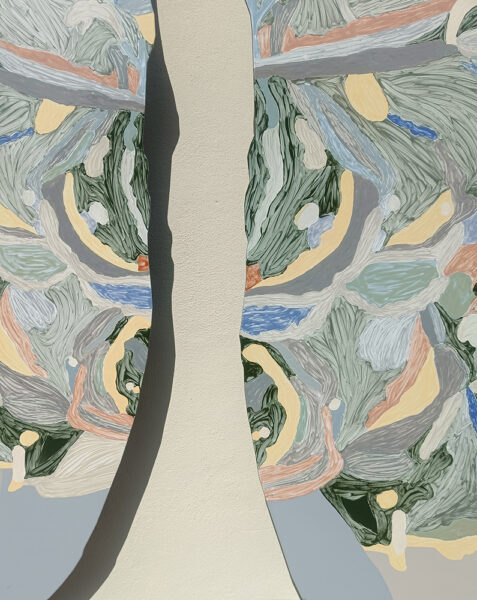THE WAY OF THE PEARL MUSSEL
The public art installation is commissioned by Poul Erik Bech Fonden for the sculpture parc Varde Garten in Varde, DK. The installation is inspired by the ‘Varde pearl’; the freshwater pearl mussel, which in Denmark only exists in Varde Å, where it has survived since the last ice age despite the ‘pearl fever’ in the 1930s, which started a direct predatory fishery for the mussel, as well as later mercury pollution in the river. For several years the mussel was considered extinct, but a recent rediscovery in connection with a new high voltage motorway, whose underground cables are drilled under the stream, gives the subject a revival. It no longer only refers back in time but also forward as a signature for a sustainable Varde, where the freshwater pearl mussel thrives again.
Visually the mussel is reflected in the work both in the silhouettes of the enamel plates and in the hand painted areas of the composition, which mirror the mussel buried in the riverbed with the back facing the current, where it lives by filtering plankton from the water.The gable motif has a blue/purple dimension, while the brickwork is composed in a green scale.The green composition in its meandering zig-zag character, is inspired by the Varde river and thus intended as an experience in motion leading towards the vertical blue scale work on the gable and the entrance to the sculpture parc Varde Garten. The organic forms are framed through joining with geometric visual accents.
The pearl mussel is characterized by a dark, elongated, kidney-shaped shell. It can live up to 140 years old and becomes sexually mature at 30 years of age. In order to complete a successful life cycle, the freshwater pearl mussel depends on various species of fish. The female ‘gives birth’ to thousands of larvae from June to September, at the same time that salmon and trout go up the streams to spawn. The larvae attach themselves to the fish’s gills and are thus transported to new habitats. This journey can last from six weeks to over 10 months. Attached to the fish, the larvae develop into young clams, which are then dropped by the fish at some point. The mussels sink to the bottom and bury themselves at a depth of 35 cm on the bottom of the stream. The young mussel lives here for 4–5 years and grows to a length of 2 cm. It can eventually become up to 15 cm long.



















